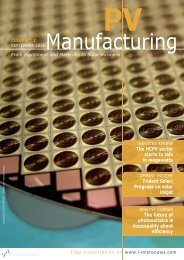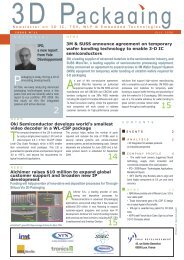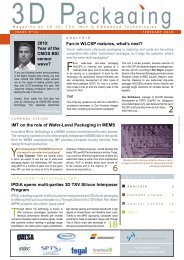the disruptive semiconductor technologies magazine - I-Micronews
the disruptive semiconductor technologies magazine - I-Micronews
the disruptive semiconductor technologies magazine - I-Micronews
Create successful ePaper yourself
Turn your PDF publications into a flip-book with our unique Google optimized e-Paper software.
OCTOBER 2010 issue n°100<br />
THE DISRUPTIVE SEMICONDUCTOR TECHNOLOGIES MAGAZINE<br />
PHOTONICS<br />
New markets inspire growth at Modulight<br />
From page 1<br />
The company’s red lasers are also gaining<br />
traction in <strong>the</strong> medical field, particularly for<br />
fluorescence, photodynamic <strong>the</strong>rapy (PDT)<br />
and surgery.<br />
In <strong>the</strong> midst of <strong>the</strong>se emerging applications, Modulight<br />
still goes back to its roots and is developing new<br />
products for communications. “Today <strong>the</strong> most<br />
interesting market segment <strong>the</strong>re is test and<br />
measurement, specifically <strong>the</strong> optical time-domain<br />
reflectometers used to characterise optical fibers,”<br />
said Petteri. “This is <strong>the</strong> ideal application for our<br />
singlemode high-power pulsed lasers emitting<br />
between 1310 and 1650 nm.”<br />
www.modulight.com<br />
OTDR lasers<br />
UGent and imec launch silicon photonics spin-off Caliopa<br />
Silicon photonics allows for small, highly integrated & low power optical transceivers for data and telecommunication.<br />
Ghent University (UGent) and imec announced<br />
<strong>the</strong> creation of Caliopa, a spin-off from <strong>the</strong>ir<br />
world leading Photonics Research Group. An<br />
initial 2 million Euro in funding was raised from<br />
Baekeland, Fidimec, PMV-Vinnof, a private investor and<br />
<strong>the</strong> founders. Caliopa will develop and market advanced<br />
silicon photonics based optical transceivers for <strong>the</strong> data<br />
and telecommunications markets.<br />
According to <strong>the</strong> latest Market Forecast from<br />
LightCounting LLC, <strong>the</strong> global sales of optical<br />
transceivers will reach $2.4 billion in 2010, with <strong>the</strong><br />
market posting a 13% compound annual growth rate<br />
(CAGR) between 2011 and 2014, as <strong>the</strong> industry<br />
catches up with <strong>the</strong> steadily growing demand for<br />
bandwidth. Caliopa will be able to build on <strong>the</strong> know-how,<br />
intellectual property and experience of years of research<br />
by <strong>the</strong> world renowned Photonics Research Group at<br />
Ghent University and imec led by Prof. Roel Baets. In<br />
addition, it will use <strong>the</strong> expertise in silicon processing of<br />
<strong>the</strong> world-leading nanoelectronics research center<br />
imec. To develop its first products, <strong>the</strong> company raised<br />
2 million Euro in funding from a consortium of investors<br />
led by Baekeland, Fidimec and PMV-Vinnof.<br />
www.caliopa.com<br />
Leti demonstrates <strong>the</strong> integration of CMOS-compatible plasmonic optical<br />
waveguides with silicon photonic devices<br />
Copper waveguides offer potential for developing smaller, more efficient, high-performance photonic components.<br />
CEA-Leti, a leading European research and<br />
development institute in <strong>the</strong> field of silicon<br />
photonics technology, announced that it has<br />
demonstrated <strong>the</strong> efficient integration of silicon<br />
photonic devices with fully complementary metal-oxide<br />
<strong>semiconductor</strong> (CMOS)-compatible plasmonic optical<br />
waveguides. This new capability sets <strong>the</strong> stage for <strong>the</strong><br />
fabrication of smaller, faster and more efficient optoelectronic<br />
interfaces, which could ultimately allow <strong>the</strong><br />
development of significantly higher-performance<br />
sensors, computer chips and o<strong>the</strong>r electronic<br />
components. Waveguides, including optical fibers, are<br />
used to transmit signals and power in a variety of radio<br />
and optical communications uses. Leti's new devices<br />
channel light through a narrow silicon waveguide<br />
placed in close proximity to a metal waveguide, causing<br />
<strong>the</strong> light to excite small, high-frequency electromagnetic<br />
waves, known as surface plasmons, in <strong>the</strong> metallic<br />
structures. The resulting devices can convert optical<br />
signals in <strong>the</strong> 1.5 micrometers (μm) communications<br />
band into plasmonic electron waves, and convert <strong>the</strong><br />
plasmonic waves back into optical signals.<br />
Leti's pioneering combination of extremely small<br />
plasmonic-optical interfaces that connect to standard<br />
optical fibers provides high coupling efficiencies (up to<br />
70 percent) over a wide spectral range. And unlike<br />
previous devices that have relied on metal waveguides<br />
made from gold, Leti's metal waveguides are fabricated<br />
with copper, allowing <strong>the</strong>m to be easily integrated into<br />
standard CMOS chip manufacturing processes.<br />
The plasmonic-optical devices were designed and<br />
fabricated by Leti, which collaborated with France's<br />
Université de Technologie de Troyes (UTT) for<br />
additional near-field scanning optical microscope<br />
testing and characterization. The project results were<br />
presented earlier this month at <strong>the</strong> Group Four<br />
Photonics 2010 show in Beijing, and published in Nano<br />
Letters, a journal of <strong>the</strong> American Chemical Society.<br />
www.leti.fr<br />
Quantum signals converted to telecom wavelengths<br />
Using optically dense, ultracold clouds of rubidium atoms, three key elements needed for quantum information systems<br />
have been advanced — including a technique for converting photons carrying quantum data to wavelengths that can<br />
be transmitted long distances on optical fiber telecom networks.<br />
The developments move quantum information<br />
networks — which securely encode information<br />
by entangling photons and atoms — closer to a<br />
possible prototype system. Researchers at <strong>the</strong> Georgia<br />
Institute of Technology reported <strong>the</strong> findings Sept. 26 in<br />
<strong>the</strong> journal Nature Physics, and in a manuscript<br />
submitted for publication in <strong>the</strong> journal Physical Review<br />
Letters.<br />
The advances include:<br />
• Development of an efficient, low-noise system for<br />
converting photons carrying quantum information at<br />
infrared wavelengths to longer wavelengths suitable<br />
for transmission on conventional telecommunications<br />
systems. The researchers have demonstrated that<br />
<strong>the</strong> system, believed to be <strong>the</strong> first of its kind, maintains<br />
<strong>the</strong> entangled information during conversion to<br />
telecom wavelengths — and back down to <strong>the</strong> original<br />
infrared wavelengths.<br />
• A significant improvement in <strong>the</strong> length of time that a<br />
quantum repeater — which would be necessary to<br />
transmit <strong>the</strong> information — can maintain <strong>the</strong> information<br />
in memory. The Georgia Tech team reported memory<br />
lasting as long as 0.1 second, 30 times longer than<br />
previously reported for systems based on cold neutral<br />
atoms and approaching <strong>the</strong> quantum memory goal of<br />
at least one second — long enough to transmit <strong>the</strong><br />
information to <strong>the</strong> next node in <strong>the</strong> network.<br />
• An efficient, low-noise system able to convert photons<br />
of telecom wavelengths back to infrared wavelengths.<br />
Such a system would be necessary for detecting<br />
entangled photons transmitted by a quantum<br />
information system.<br />
www.gatech.edu<br />
Experimental equipment used to study quantum<br />
information systems at Georgia Tech<br />
Copyrights © Yole Développement SA. All rights reserved - Recycled paper<br />
15
















